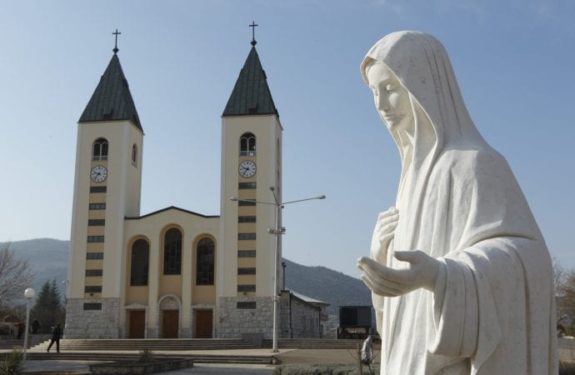
By Claire Giangravè
ROME (Crux) – For years the credibility of the Eastern European Marian pilgrimage site of Medjugorje and the miraculous happenings that allegedly occur there, have been the subject of questioning and doubt. But its continued following and devotion have pushed the Vatican into recognizing its validity.
Well, sort of.
“Medjugorje is an international reference point for prayer where extraordinary spiritual fruits can be touched by hand,” said Polish Archbishop Henryk Hoser, the Holy See’s Special Envoy to Medjugorje, in a July 22 interview with the publication of the Italian bishops, Avvenire.
The prelate pointed to the number of conversions, vocations and sacraments that take place at the pilgrimage site as an example of the positive effects that this place has on the Catholic community, adding that he doesn’t believe “there are traces of heresy.”
Hoser, 76, was appointed to his role by Pope Francis in February 2017 and is today in charge of administering to the pastoral needs of pilgrims and serving as a liaison between the local Franciscan community and the Catholic hierarchy.
One year after his appointment, the Polish prelate announced that pilgrimages were allowed once again to Medjugorje, the last step of an ongoing debate regarding how much official Vatican backing should be given to the popular – albeit ambiguous – site.
“People claim to feel the presence of Mary,” Hoser said, “but allowing pilgrimages must not be interpreted as an authentication of the known events tied to the name Medjugorje.”
He continued to state that the site is “a place, blessed by God, of encounter and dialogue with the Lord through the Virgin.”
Beloved by Catholic faithful, especially from Italy and Eastern Europe, this Marian site is Europe’s third most popular pilgrimage destination after Lourdes, France, and Fatima, Portugal. According to media reports, over 30 million believers have come to Medjugorje since the first apparitions were reported.
On June 24, 1981, six youths between the ages of 10 and 16 claimed to have witnessed the apparitions of the Virgin Mary on the Podbrdo hill in Medjugorje, Southern Bosnia. They said that Mary introduced herself as the “Queen of Peace” and that she continues to speak to them cyclically.
Hoser said that the witnesses are older today, with wives and children, and many of them have dedicated themselves to the welcoming of pilgrims. “When I spoke to one of them, he started crying like a child because he believed to have been wounded by so many voices,” he said.
Three of the visionaries claim that Mary appears to them each day, while the remaining three say they have the same experience once a year. Following three diocesan commissions, the then-Yugoslavian bishops decided that it was “impossible to determine whether we are dealing with apparition or supranatural revelations” in a 1991 declaration in Zara.
The local bishop clashed with the Franciscans who had been associated with the visionaries, and the friars were expelled in 1999. In 2008, the spiritual director for the visionaries was suspended “for the diffusion of dubious doctrine, manipulation of consciences, suspicious mysticism, disobedience toward legitimately issued orders.”
Despite these setbacks, the apparition site continued to attract up to 1 million pilgrims each year.
Another probe to determine the validity of the pilgrimage site was launched in 2010 by Pope Benedict XVI and led by the former Vicar of Rome Cardinal Camillo Ruini. The commission finished its work in 2014 and handed in their results to the Vatican’s Congregation for the Doctrine of the Faith.
The results of the inquiry were kept secret and Francis sent Hoser to oversee Medjugorje, waiting on the decision of whether or not to sanction the pilgrimage site. Still, the Argentinian pontiff known for being partial to popular devotions, expressed a few concerns about the Marian site.
“Personally, I am more skeptical,” Francis said aboard the papal plane returning from the Marian shrine at Lourdes in June 2015. “I prefer Our Lady to be a Mother, our Mother, and not a telegraph operator who sends out a message every day at a certain time… this is not the mother of Jesus.”
“Who thinks that Our Lady would say: ‘Come tomorrow at this time and I will give a message to that seer.’ No,” he added.
The pope said that the Ruini report expressed the need for more investigation on the original apparitions and “expressed doubts” concerning the yearly apparitions that have occurred since. But Francis added that the “real core” of the report was the spiritual devotions elicited by the pilgrimage site.
“For this there is no magic wand, this spiritual-pastoral fact cannot be denied,” he said.
The papal representative to Medjugorje seconded that feeling by illustrating the many cases where miracles occur on the Marian site without having to refer to the supernatural. In the past weeks, 400 priests gathered in Medjugorje for an international clerical retreat. Near the site, the “Village of the Mother” hosts orphans, women in crisis, the disabled, drug addicts and all those in need.
“I can testify that at Medjugorje the Mother of God is at the heart of everything, independently from eventual supernatural occurrences,” said the Vatican’ s Apostolic Nunzio to Bosnia and Herzegovina, Archbishop Luigi Pezzuto, in the same Avvenire story.
“The farsighted decision of the pope to disconnect the closeness to the pilgrims to the recognition or not of the alleged visions shows the care that the Church has toward all those who entrust themselves with a sincere heart to the maternal intercession of Mary, also by going to this small town in Herzegovina.”
In the coming days two close papal allies will be visiting Medjugorje. Cardinal Gualtiero Bassetti, who heads the Italian episcopal conference and is currently at the Marian site, while the Vicar of Rome, Cardinal Angelo De Donatis, will be inaugurating the International Youth Festival there on August 1.
